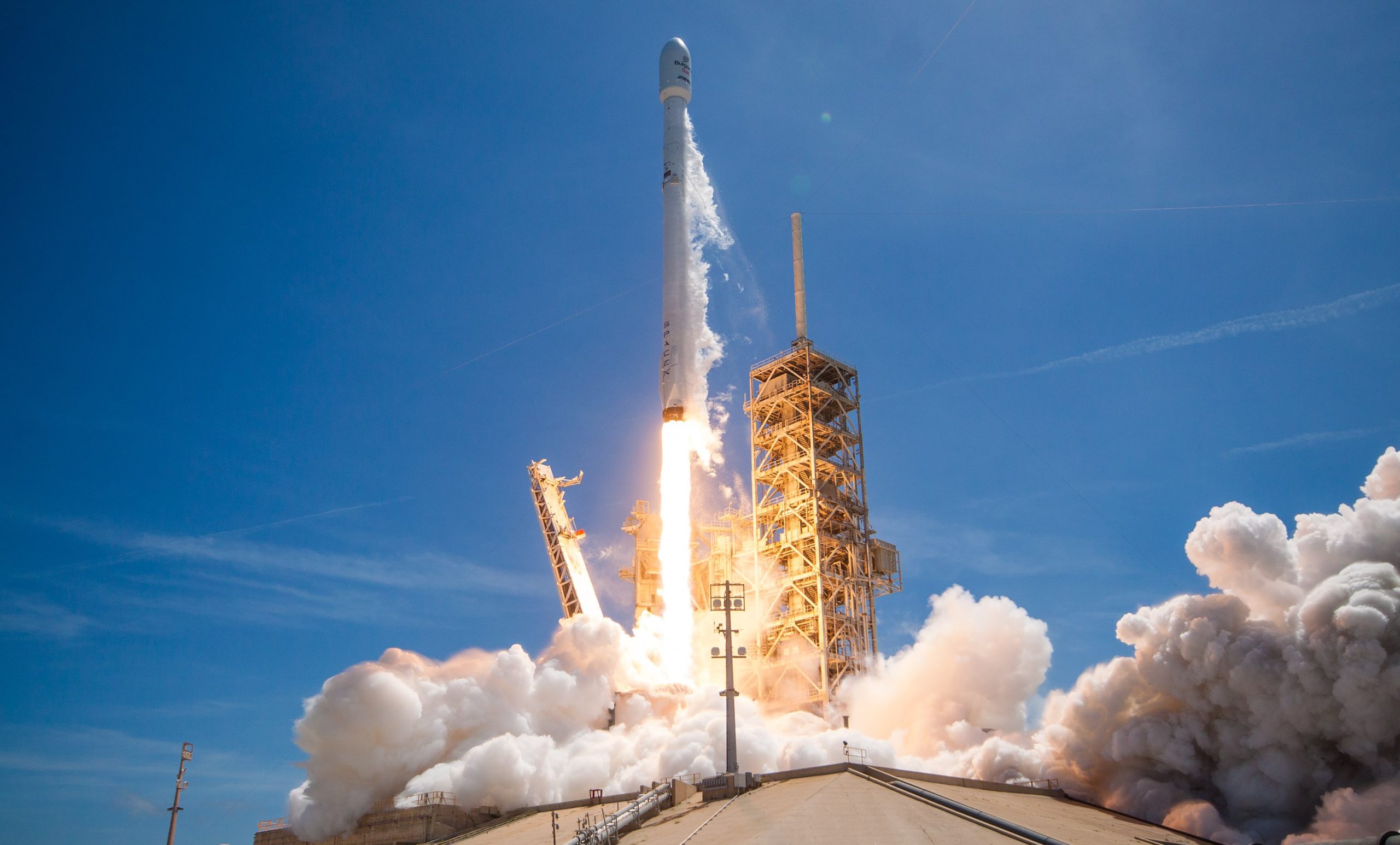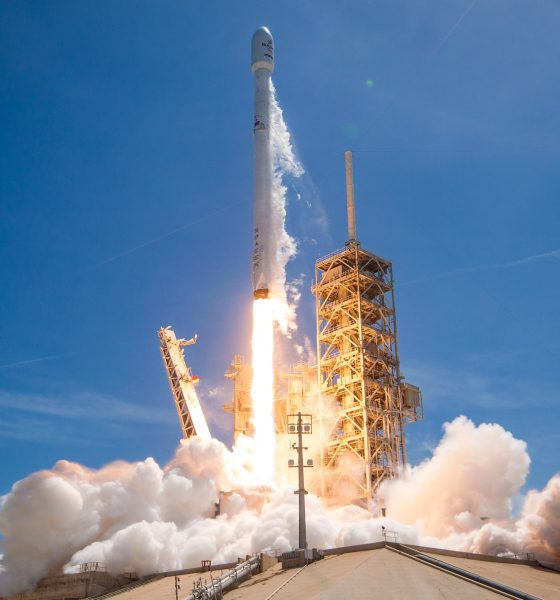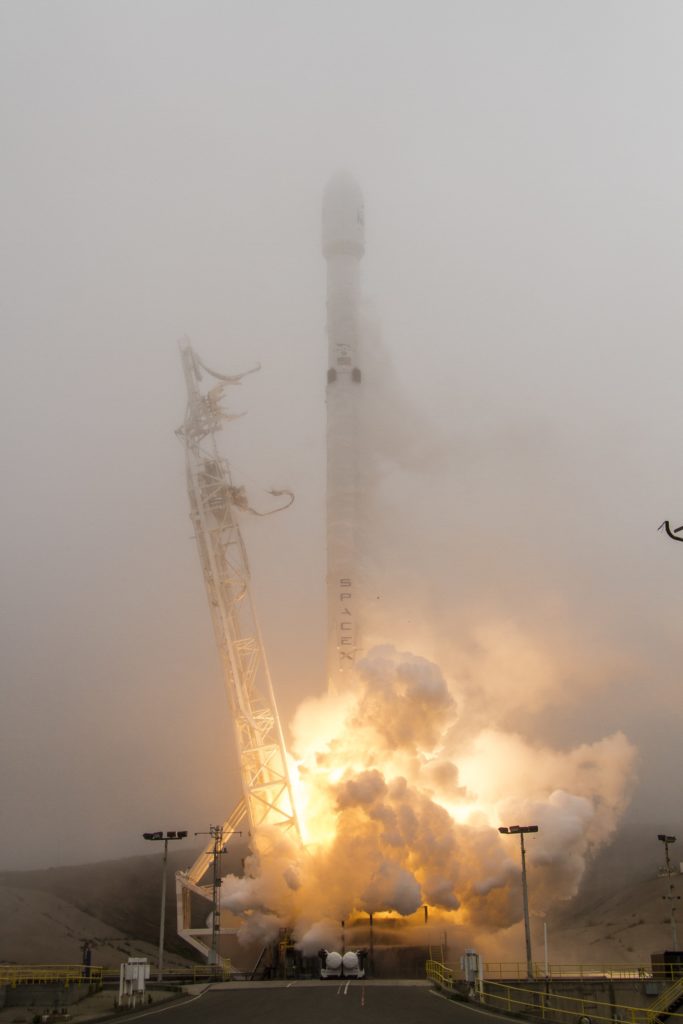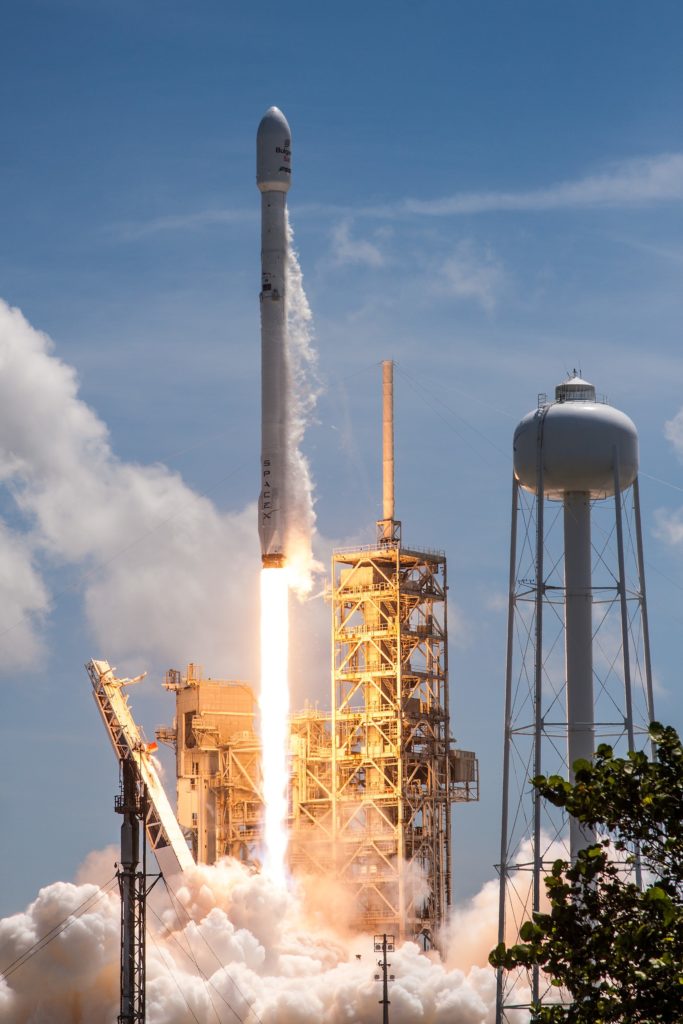

News
SpaceX on track for biweekly launch cadence in the remainder of year
Weekly rapid reuse launches expected by 2019

The foggy, atmospheric launch of Iridium-2 just yesterday. (SpaceX)
Following a weekend of extraordinary accomplishments, seeing SpaceX flawlessly execute two missions – one with a reused first stage – in just over 48 hours of each other, the company has capitalized on a uniquely successful weekend and year and offered information about their future plans.
The launch of BulgariaSat-1 and Iridium-2 on Friday and Sunday respectively marked the eight and ninth launches of 2017 for SpaceX, and officials at the company are reportedly expecting to launch approximately 24 missions this year, meaning 15 more to come over the next 6 months. Given the recent demonstration of 48 hour launch cadence and a more regular schedule of biweekly launches in the past few months, an expectation of 15 more launches for 2017 lines up perfectly with a cadence of two launches a month from LC-39A Cape Canaveral and three Iridium launches from Vandenberg, which happens to be exactly what is currently manifested.
Originally manifested for up to 27 launches this year, successfully launching 24 missions, one of which might be the inaugural flight of Falcon Heavy, would be extraordinarily hard to ignore in an industry that has compared the launch industry to manufacturing beverage containers and argued that reuse is only sustainable with more than 20 launches a year on a company’s manifest.

BulgariaSat-1 was successfully launched 48 hours before Iridium-2, and marked the second successful, commercial reuse of an orbital rocket. (SpaceX)
SpaceX is now likely to undertake 24 launches this year, but the company also revealed this weekend that it intends to achieve a regular weekly launch cadence (52 launches per year) as soon as 2019. In a recent article, I speculated that we might begin to see regular weekly launches once both LC-39A and LC-40 were active, and that appears to be nearly correct. If SpaceX is to regularly conduct weekly launches by 2019, it is bound to begin shrinking its two week cadence as soon as is safe and possible. This will likely occur once Falcon Heavy has successfully flown several times from LC-39A, thus freeing SpaceX to deem the vehicle operational and less at risk of destroying one of their two Eastern pads.
There is also a tentative understanding that SpaceX is striving to construct and activate their planned Boca Chica, Texas launch complex by 2019. The successful reactivation of LC-40 and subsequent modification of LC-39A for Falcon Heavy will leave the brunt of SpaceX’s launch complex maintenance and construction teams free to focus entirely on the Texas facility sometime late this year or early next year, meaning that Boca Chica pad activation could certainly occur as early as 2019. This would leave the company with two fully operational all-purpose launch pads dedicated to Falcon 9 launches if they choose to retain LC-39A solely for Falcon Heavy and Commercial Crew launches, allowing them to reach weekly cadences even before the launches of Falcon Heavy, Commercial Crew contracts, and Vandenberg launches are accounted for.
One crucial factor playing into SpaceX’s ability to launch 52 times in a year is of course reusability, as it is hard to imagine SpaceX more than doubling their Falcon manufacturing capabilities in under a year and a half. Likely no coincidence, SpaceX simultaneously offered information to insurance underwriters about the increasing speed of their ability to launch, recover, and reuse first stages. More specifically, a spokesman of the company stated that the reuse of BulgariaSat-1’s Falcon 9 1029 took considerably less than half as long as the inaugural reuse of the stage that launched SES-10 earlier this year, implying that refurbishment and quality assurance checks for 1029 took something like four or five months total.
With SpaceX having debuted new titanium grid fins intended to speed up reuse on the Sunday launch of Iridium-2, the company is well on its way to transferring over to Block 4 (upgraded engine performance) and possibly Block 5 of Falcon 9 later this. Block 5 is expected to introduced major changes meant to replace aspects of the current Falcon 9 that require major refurbishment after recovery. Musk detailed these changes several months ago in a Reddit AMA (Ask Me Anything), mentioning that reusable heat shielding around the engines, improved landing legs, and titanium grid fins were the main aspects of a Block 5 of Falcon 9 meant to offer rapid reuse without refurbishment. In June 22nd interview on the Space Show, Gwynne Shotwell reiterated that this “final” version of Falcon 9 is expected to be able to launch, land, and relaunch with barely more than a thorough once-over, and ought to be capable of flying a dozen missions at least.

Falcon 9’s fancy new titanium grid fins. (SpaceX/Instagram)
This final piece of the puzzle of weekly cadence fits in quite nicely. With a possible introduction date for Block 5 of late 2017 or early 2018, SpaceX will likely end production of Block 3 by the end of this year and transfer over entirely to the easily reusable Block 5. Assuming a continuing a trend of increasingly reuse-friendly customers, Hawthorne production capacity of approximately 20 Falcon 9s per year, and a plausibly significant reduction in launch costs due to more rapid and complete reuse, SpaceX could find themselves at the start of 2019 with a dozen or more launch vehicles that are each capable of conducting upwards of 10-12 highly affordable launches each.
Let there be no doubt: these are incredibly optimistic and difficult goals for the company to achieve on the timescale they have provided. However, given the number of beneficial changes likely to soon be made to both the launch vehicles and SpaceX’s manufacturing, launch, and refurbishment facilities in the next 6-12 months, those goals are realistically achievable, albeit with some likely delays. Regardless, things are beginning to get rather intense for SpaceX and for the launch industry in general.
Keep your eyes peeled for upcoming Teslarati coverage of SpaceX’s next July 4th launch and its static fire that is scheduled for as soon as this Thursday.

News
Tesla Model 3 becomes Netherlands’ best-selling used EV in 2025
More than one in ten second-hand electric cars sold in the country last year was a Tesla Model 3.

The Tesla Model 3 became the most popular used electric car in the Netherlands in 2025, cementing its dominance well beyond the country’s new-car market.
After years at the top of Dutch EV sales charts, the Model 3 now leads the country’s second-hand EV market by a wide margin, as record used-car purchases pushed electric vehicles further into the mainstream.
Model 3 takes a commanding lead
The Netherlands recorded more than 2.1 million used car sales last year, the highest level on record. Of those, roughly 4.8%, or about 102,000 vehicles, were electric. Within that growing segment, the Tesla Model 3 stood far ahead of its competitors.
In 2025 alone, 11,338 used Model 3s changed hands, giving the car an 11.1% share of the country’s entire used EV market. That means more than one in ten second-hand electric cars sold in the country last year was a Tesla Model 3, Auto Week Netherlands reported. The scale of its lead is striking: the gap between the Model 3 and the second-place finisher, the Volkswagen ID3, is more than 6,700 vehicles.
Rivals trail as residual values shape rankings
The Volkswagen ID.3 ranked a distant second, with 4,595 used units sold and a 4.5% market share. Close behind was the Audi e-tron, which placed third with 4,236 registrations. As noted by Auto Week Netherlands, relatively low residual values likely boosted the e-tron’s appeal in the used market, despite its higher original price.
Other strong performers included the Kia Niro, the Tesla Model Y, and the Hyundai Kona, highlighting continued demand for compact and midsize electric vehicles with proven range and reliability. No other model, however, came close to matching the Model 3’s scale or market presence.
News
Tesla Model Y Standard Long Range RWD launches in Europe
The update was announced by Tesla Europe & Middle East in a post on its official social media account on X.

Tesla has expanded the Model Y lineup in Europe with the introduction of the Standard Long Range RWD variant, which offers an impressive 657 km of WLTP range.
The update was announced by Tesla Europe & Middle East in a post on its official social media account on X.
Model Y Standard Long Range RWD Details
Tesla Europe & Middle East highlighted some of the Model Y Standard Long Range RWD’s most notable specs, from its 657 km of WLTP range to its 2,118 liters of cargo volume. More importantly, Tesla also noted that the newly released variant only consumes 12.7 kWh per 100 km, making it the most efficient Model Y to date.
The Model Y Standard provides a lower entry point for consumers who wish to enter the Tesla ecosystem at the lowest possible price. While the Model 3 Standard is still more affordable, some consumers might prefer the Model Y Standard due to its larger size and crossover form factor. The fact that the Model Y Standard is equipped with Tesla’s AI4 computer also makes it ready for FSD’s eventual rollout to the region.
Top Gear’s Model Y Standard review
Top Gear‘s recent review of the Tesla Model Y Standard highlighted some of the vehicle’s most notable features, such as its impressive real-world range, stellar infotainment system, and spacious interior. As per the publication, the Model Y Standard still retains a lot of what makes Tesla’s vehicles well-rounded, even if it’s been equipped with a simplified interior.
Top Gear compared the Model Y Standard to its rivals in the same segment. “The introduction of the Standard trim brings the Model Y in line with the entry price of most of its closest competition. In fact, it’s actually cheaper than a Peugeot e-3008 and costs £5k less than an entry-level Audi Q4 e-tron. It also makes the Ford Mustang Mach-E look a little short with its higher entry price and worse range,” the publication wrote.
Elon Musk
Elon Musk’s xAI bets $20B on Mississippi with 2GW AI data center project
The project is expected to create hundreds of permanent jobs, dramatically expand xAI’s computing capacity, and further cement the Mid-South as a growing hub for AI infrastructure.

Elon Musk’s xAI plans to pour more than $20 billion into a massive new data center campus in Southaven, Mississippi, marking the largest single economic development project in the state’s history.
The project is expected to create hundreds of permanent jobs, dramatically expand xAI’s computing capacity, and further cement the Mid-South as a growing hub for AI infrastructure.
xAI goes MACROHARDRR in Mississippi
xAI has acquired and is retrofitting an existing facility in Southaven to serve as a new data center, which will be known as “MACROHARDRR.” The site sits near a recently acquired power plant and close to one of xAI’s existing data centers in Tennessee, creating a regional cluster designed to support large-scale AI training and inference.
Once completed, the Southaven facility is expected to push the company’s total computing capacity to nearly 2 GW, placing it among the most powerful AI compute installations globally. The data center is scheduled to begin operations in February 2026.
Gov. Tate Reeves shared his optimism about the project in a press release. “This record-shattering $20 billion investment is an amazing start to what is sure to be another incredible year for economic development in Mississippi. Today, Elon Musk is bringing xAI to DeSoto County, a project that will transform the region and bring amazing opportunities to its residents for generations. This is the largest economic development project in Mississippi’s history,” he said.
xAI’s broader AI ambitions
To secure the investment, the Mississippi Development Authority approved xAI for its Data Center Incentive program, which provides sales and use tax exemptions on eligible computing hardware and software. The City of Southaven and DeSoto County are also supporting the project through fee-in-lieu agreements aimed at accelerating development timelines and reducing upfront costs.
Founded in 2023 by Elon Musk, xAI develops advanced artificial intelligence systems focused on large-scale reasoning and generative applications. Its flagship product, Grok, is integrated with the social media platform X, alongside a growing suite of APIs for image generation, voice, and autonomous agents, including offerings tailored for government use.
Elon Musk highlighted xAi’s growth and momentum in a comment about the matter. “xAI is scaling at an immeasurable pace — we are building our third massive data center in the greater Memphis area. MACROHARDRR pushes our Colossus training compute to ~2GW – by far the most powerful AI system on Earth. This is insane execution speed by xAI and the state of Mississippi. We are grateful to Governor Reeves for his support of building xAI at warp speed,” Musk said.








